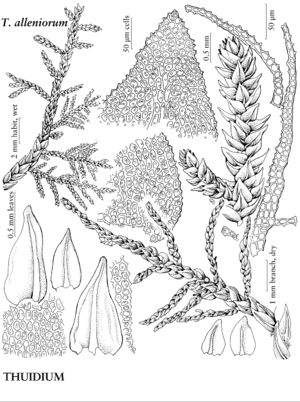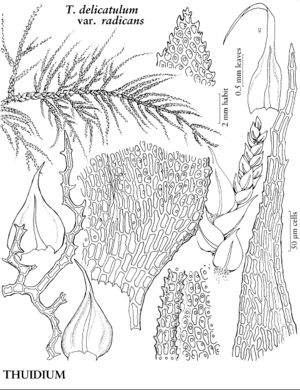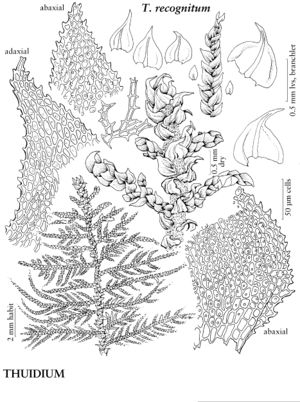Thuidium
in P. Bruch and W. P. Schimper, Bryol. Europ. 5: 157, plates 481 – 486. 1852.
| Taxon | Illustrator ⠉ | |
|---|---|---|
 | Thuidium alleniorum | Patricia M. Eckel |
 | Thuidium delicatulum var. radicans | Patricia M. Eckel |
 | Thuidium recognitum | Patricia M. Eckel |
| ... further results | ||
Plants large. Stems creeping to arched-ascending, 2-pinnate or 3-pinnate; paraphyllia mostly foliose, lanceolate or filiform-branched; axillary hairs 2–6 (–7) -celled. Stem-leaves ovate; margins plane, reflexed, or revolute, papillose-serrulate proximally, often serrulate distally by projecting cell ends; costa ending before apex; laminal cells rounded to oblong-hexagonal, rhombic, or elliptic, coarsely 1-papillose abaxially, papillae sometimes 2-fid, appearing multipapillose. Branch leaves ovate; margins incurved, erect, or recurved, entire to denticulate; apex usually acute; costa ending before apex, not covered with cells apically; laminal cells rounded, hexagonal, elliptic, or oblong-rhombic, 1-papillose. Sexual condition dioicous; perichaetial leaves lanceolate or ovatelanceolate, margins sometimes ciliate, costa ending near apex, laminal cells smooth or somewhat papillose. Seta smooth or rarely papillose. Capsule inclined to horizontal, curved-cylindric, asymmetric; annulus 2–4-seriate; operculum conic or rostrate from convex-conic base; endostome segments not perforate, cilia in groups of 2–4.
Distribution
North America, Mexico, West Indies, Central America, South America, Europe, Asia
Discussion
Species ca. 230 (4 in the flora).
Thuidium is characterized by abundant, 2- or 3-pinnate paraphyllia; dioicous sexuality; dimorphic stem and branch leaves with short, thick-walled cells that are papillose abaxially and nearly always 1-papillose; stem leaves with base ± plicate and laminal cells ± uniform; apical cells of branch leaves usually truncate and multipapillose; and setae nearly always smooth. The capsule is smooth, with a short neck. The genus is treated here in a sense exclusive of Abietinella, Cyrto-hypnum, and Rauiella (see W. R. Buck and H. A. Crum 1990). Abietinella is relatively robust and has 1-pinnate branching, abundant paraphyllia, dioicous inflorescences, laminal cells 1-papillose on both surfaces, and 3- or 4-celled, brown axillary hairs. Cyrto-hypnum and Rauiella are small with autoicous inflorescences, paraphyllia short and not much branched, and laminal cells papillose on both surfaces (most commonly multipapillose). Cyrto-hypnum has mostly 2-pinnate branching, 2-celled axillary hairs, leaves incurved when dry, laminal cells plane, and setae often roughened. Rauiella has 1-pinnate branching, 3-celled axillary hairs, leaves not incurved when dry, strongly bulging laminal cells, and smooth setae.
Selected References
None.
Key
| 1 | Stems usually 3-pinnate; branch leaf apical cell acute, smooth. | Thuidium tamariscinum |
| 1 | Stems usually 2-pinnate; branch leaf apical cell truncate, multipapillose | > 2 |
| 2 | Stem leaves incurved basally and spreading apically when dry, distinctly plicate; costae nearly filling acumen; paraphyllia papillose at cell ends. | Thuidium recognitum |
| 2 | Stem leaves ± erect when dry, not or somewhat plicate; costae not filling acumen; paraphyllia papillose at sides of cells or cell ends | > 3 |
| 3 | Stem leaf apices short-pointed; margins plane or sometimes reflexed basally; distal laminal cells appearing 1-3-papillose because papillae 2-fid. | Thuidium alleniorum |
| 3 | Stem leaf apices acuminate; margins revolute throughout; laminal cells coarsely 1-papillose, not appearing multipapillose, papillae sometimes 2-fid. | Thuidium delicatulum |